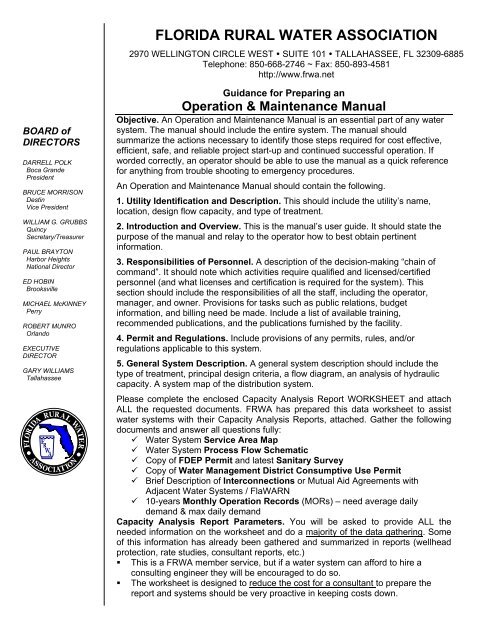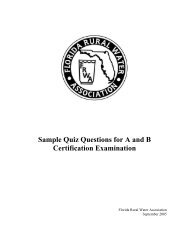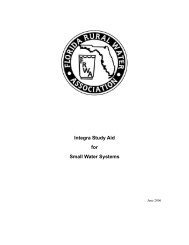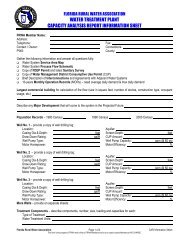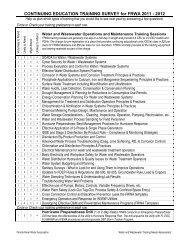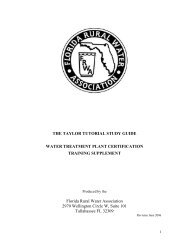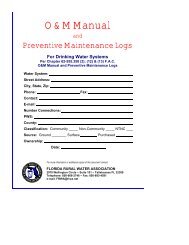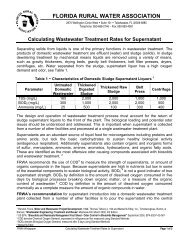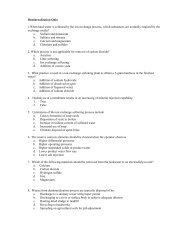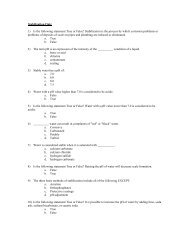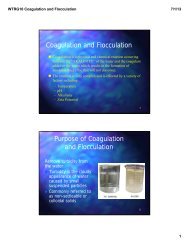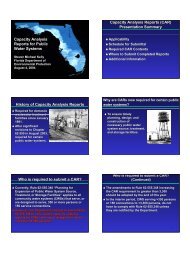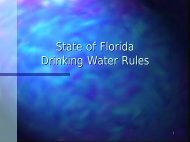Operation & Maintenance Manual - Florida Rural Water Association
Operation & Maintenance Manual - Florida Rural Water Association
Operation & Maintenance Manual - Florida Rural Water Association
You also want an ePaper? Increase the reach of your titles
YUMPU automatically turns print PDFs into web optimized ePapers that Google loves.
FLORIDA RURAL WATER ASSOCIATION<br />
2970 WELLINGTON CIRCLE WEST • SUITE 101 • TALLAHASSEE, FL 32309-6885<br />
Telephone: 850-668-2746 ~ Fax: 850-893-4581<br />
http://www.frwa.net<br />
BOARD of<br />
DIRECTORS<br />
DARRELL POLK<br />
Boca Grande<br />
President<br />
BRUCE MORRISON<br />
Destin<br />
Vice President<br />
WILLIAM G. GRUBBS<br />
Quincy<br />
Secretary/Treasurer<br />
PAUL BRAYTON<br />
Harbor Heights<br />
National Director<br />
ED HOBIN<br />
Brooksville<br />
MICHAEL McKINNEY<br />
Perry<br />
ROBERT MUNRO<br />
Orlando<br />
EXECUTIVE<br />
DIRECTOR<br />
GARY WILLIAMS<br />
Tallahassee<br />
Guidance for Preparing an<br />
<strong>Operation</strong> & <strong>Maintenance</strong> <strong>Manual</strong><br />
Objective. An <strong>Operation</strong> and <strong>Maintenance</strong> <strong>Manual</strong> is an essential part of any water<br />
system. The manual should include the entire system. The manual should<br />
summarize the actions necessary to identify those steps required for cost effective,<br />
efficient, safe, and reliable project start-up and continued successful operation. If<br />
worded correctly, an operator should be able to use the manual as a quick reference<br />
for anything from trouble shooting to emergency procedures.<br />
An <strong>Operation</strong> and <strong>Maintenance</strong> <strong>Manual</strong> should contain the following.<br />
1. Utility Identification and Description. This should include the utility’s name,<br />
location, design flow capacity, and type of treatment.<br />
2. Introduction and Overview. This is the manual’s user guide. It should state the<br />
purpose of the manual and relay to the operator how to best obtain pertinent<br />
information.<br />
3. Responsibilities of Personnel. A description of the decision-making “chain of<br />
command”. It should note which activities require qualified and licensed/certified<br />
personnel (and what licenses and certification is required for the system). This<br />
section should include the responsibilities of all the staff, including the operator,<br />
manager, and owner. Provisions for tasks such as public relations, budget<br />
information, and billing need be made. Include a list of available training,<br />
recommended publications, and the publications furnished by the facility.<br />
4. Permit and Regulations. Include provisions of any permits, rules, and/or<br />
regulations applicable to this system.<br />
5. General System Description. A general system description should include the<br />
type of treatment, principal design criteria, a flow diagram, an analysis of hydraulic<br />
capacity. A system map of the distribution system.<br />
Please complete the enclosed Capacity Analysis Report WORKSHEET and attach<br />
ALL the requested documents. FRWA has prepared this data worksheet to assist<br />
water systems with their Capacity Analysis Reports, attached. Gather the following<br />
documents and answer all questions fully:<br />
<strong>Water</strong> System Service Area Map<br />
<strong>Water</strong> System Process Flow Schematic<br />
Copy of FDEP Permit and latest Sanitary Survey<br />
Copy of <strong>Water</strong> Management District Consumptive Use Permit<br />
Brief Description of Interconnections or Mutual Aid Agreements with<br />
Adjacent <strong>Water</strong> Systems / FlaWARN<br />
10-years Monthly <strong>Operation</strong> Records (MORs) – need average daily<br />
demand & max daily demand<br />
Capacity Analysis Report Parameters. You will be asked to provide ALL the<br />
needed information on the worksheet and do a majority of the data gathering. Some<br />
of this information has already been gathered and summarized in reports (wellhead<br />
protection, rate studies, consultant reports, etc.)<br />
• This is a FRWA member service, but if a water system can afford to hire a<br />
consulting engineer they will be encouraged to do so.<br />
• The worksheet is designed to reduce the cost for a consultant to prepare the<br />
report and systems should be very proactive in keeping costs down.
6. System <strong>Operation</strong> and Control. It is important to fully understand how the water system operates.<br />
This section should include;<br />
A. Identification of Major System Components including a description of the normal operation of the<br />
component. Show the relationship of each component with other system components, and relate any<br />
possible alternative operation modes and circumstances under which they would be used. Include<br />
schematic diagrams of each unit and discuss any special features that may be of importance.<br />
B. Preventative <strong>Maintenance</strong> Program; describe for each major component the preventative<br />
maintenance tasks (if any) that are performed. This should include types of preventative maintenance<br />
or inspection required; frequency of maintenance or inspection; and any extraordinary changes to<br />
operations which would occur when a facility is off-line.<br />
C. Common operating problems should be discussed along with methods of bypassing units, and the<br />
importance of and how to use laboratory tests for unit control.<br />
D. Routine System <strong>Operation</strong>; for each major system component describe the routine operational tasks<br />
that are performed and controlled. This should include start-up and shut down procedures, safety<br />
procedures, meter reading and how system performance is evaluated.<br />
7. Laboratory Testing. This should include any samples and tests needed for compliance as well as<br />
for process control. For samples taken by the State, or taken by the system and analyzed by a State<br />
laboratory:<br />
• Type of sample<br />
• Sampling locations;<br />
• Monitoring schedule;<br />
For tests to be performed by outside laboratories:<br />
• Name of the laboratory<br />
• Contact person<br />
• Telephone number<br />
• Type of sample<br />
• Sampling locations;<br />
• Monitoring schedule;<br />
8. Records and Reports. Keeping and compiling records is a valuable part of an efficient water<br />
system. The following should be included in the manual:<br />
• A general explanation of the importance of records & reports;<br />
• The system should maintain a list of complaints and identify responses made;<br />
• Daily logs, maintenance records, laboratory records, monthly reports, monitoring reports,<br />
annual reports, operating cost reports, accident reports, and sanitary surveys. Examples<br />
and sample reports of each should be included;<br />
• A listing of records that are on file (permits and standards, consumption);<br />
• Location of records on file;<br />
• Procedures for reporting records to appropriate agencies;<br />
• Specify how long records should be kept on file;<br />
9. <strong>Maintenance</strong>. General maintenance is imperative in keeping a plant in working condition. The<br />
following items should be included;<br />
• Purpose of doing maintenance;<br />
• General maintenance information;<br />
• Preventative maintenance schedule and sample worksheets and instructions for completion;<br />
• Specifications for fuels, lubricants, filters, etc. for equipment;<br />
• Trouble shooting charts or guides which references pages in O&M manual and<br />
manufactures O&M manual;<br />
• Record system for each type of equipment, this should include; numbering system, catalog,<br />
nameplate data cards, maintenance record cards;<br />
<strong>Florida</strong> <strong>Rural</strong> <strong>Water</strong> <strong>Association</strong> Page 2 of 4 O&M MANUAL GUIDE<br />
This form is considered the property of and proprietary to FRWA; is provided free to FRWA Members; and is to be used to assist Members at NO CHARGE.
• Manufacturers maintenance schedule for routine adjustments. A summary with references to<br />
page number in manufacturer’s O&M manual needs to be provided;<br />
• A work order system for maintenance of equipment with sample forms.<br />
10. Storeroom and Inventory System. Equipment owned by the system should be maintained in good<br />
working order and should be available for use at all times. An inventory tracking system for equipment<br />
should include:<br />
• An inventory of all property and equipment, both moveable and non-moveable, owned by<br />
the system;<br />
• A mechanism for assigning specific items of moveable equipment to individual employees<br />
(e.g. vehicles, tools, etc.)<br />
• A mechanism for tracking specific items of moveable equipment by location (e.g. furniture,<br />
office equipment, etc.)<br />
• A mechanism for storage and checking out of specialized items of equipment needed<br />
infrequently.<br />
• Brief operation instructions for each item of equipment with reference to the manufacturers’<br />
technical specifications for major system components;<br />
• List of warranted equipment and the warranty provisions;<br />
• List of outside contract maintenance tasks;<br />
• List of equipment manufacturers;<br />
• Special tools list;<br />
Stocks of spare parts, supplies, chemicals, and other consumable items should be maintained in a<br />
secure storage location with limited access. A storeroom inventory system should include:<br />
• Lists of chemicals, supplies, and spare parts kept permanently available;<br />
• Recommended stock levels of supplies and chemicals and method of reordering when stock<br />
on hand drops below recommended levels;<br />
• List of major suppliers with telephone numbers and contact persons;<br />
• A system of requisitions and/or work orders used to distribute parts, supplies, chemicals,<br />
etc. to employees.<br />
• Lists of equipment and spare parts should clearly indicate those items of equipment and<br />
parts that are essential to the operation of the system.<br />
11. Emergency Response Program.<br />
A. An operating plan for emergencies and the procedures to be followed until normal operation can<br />
be resumed. This plan should include personnel assignments, emergency equipment inventory,<br />
and emergency numbers. Phone numbers to keep readily accessible should be police and fire<br />
departments, and for chemical spills or exposure CHEMTECH 800 424-9300. The emergency<br />
call up list should identify, in ranked order, water system personnel responsible for making<br />
decisions in specific situations. This list should include the job title, home and work phone<br />
number (beeper/car phone number if available) for all personnel.<br />
B. A contingency plan should also be made to insure proper treatment of water even inadverse<br />
conditions. This plan should describe conditions and procedures for putting standby and<br />
emergency sources into active service. Procedures for notifying customers, the local health<br />
jurisdiction, and DEP of noticeable water quality problems.<br />
C. Safety procedures should identify work space hazards for the waste water system. Potential<br />
hazards include asbestos coated pipes, mechanical equipment, electrical, explosion and fire,<br />
chlorine, oxygen deficiency, laboratory and any chemicals used by the plant. A potential danger<br />
at plants can stem from the chlorination process. The manual should provide information on<br />
how to do the following task;<br />
1. Handling of chlorine containers.<br />
A. Forklift trucks or hoisting equipment with special cradles or carriages designed for chlorine<br />
equipment are used for lifting cylinders;<br />
B. Proper storage of containers;<br />
C. Tag empty containers, and store separate from full cylinders;<br />
<strong>Florida</strong> <strong>Rural</strong> <strong>Water</strong> <strong>Association</strong> Page 3 of 4 O&M MANUAL GUIDE<br />
This form is considered the property of and proprietary to FRWA; is provided free to FRWA Members; and is to be used to assist Members at NO CHARGE.
D. Use cylinders in order that they are received;<br />
E. Use approved tools;<br />
F. Cylinder emergency repair kits should be readily available;<br />
2. Emergency procedures and emergency equipment.<br />
A. Written procedures in event of catastrophic leak or container rupture.<br />
B. Self-contained pressure helmets; with own compressed air supply and full-face piece; located at<br />
readily accessible points, away from area(s) likely to be contaminated with chlorine gas.<br />
C. Spare cylinders on site for use during prolonged emergencies.<br />
D. Inspect helmets, emergency kits, and breathing air supply tanks routinely.<br />
E. Formal training for potential users of helmets and emergency equipment.<br />
3. Leak detection<br />
A. A strong solution of aqueous ammonia is available for use in locating source of leaks<br />
B. Repairs of chlorine leaks are to be done by at least two people. Protecting gear should be used,<br />
and if below grade, safety harnesses and ropes are worn and emergency rescue operators are<br />
present.<br />
C. Piping and valves in chlorine rooms should be color coded and labeled for rapid identification.<br />
D. Properly train repair people.<br />
12. Utilities. List all the utilities serving the system, including phone numbers and contact persons.<br />
13. Appendix. The appendix should contain documents and other information that cannot be easily<br />
incorporated into the main body of the manual. Large documents such as copies of plans and<br />
specifications may be stored separately from the main manual. Examples of items that might be<br />
included in appendices are:<br />
• Detailed design criteria;<br />
• Approved shop drawings;<br />
• As built drawings;<br />
• Schematics;<br />
• Manufacturers’ manuals;<br />
• Warranties;<br />
• Valve indices or schedule;<br />
• Piping color codes;<br />
• Sample forms;<br />
• List of lab chemicals;<br />
• Copies of any permits applicable to the system<br />
• Drinking water rules;<br />
• Recommended references;<br />
• Drinking <strong>Water</strong> Ordinance;<br />
• User Charge System<br />
<strong>Florida</strong> <strong>Rural</strong> <strong>Water</strong> <strong>Association</strong> Page 4 of 4 O&M MANUAL GUIDE<br />
This form is considered the property of and proprietary to FRWA; is provided free to FRWA Members; and is to be used to assist Members at NO CHARGE.


